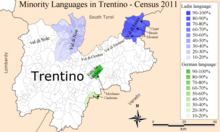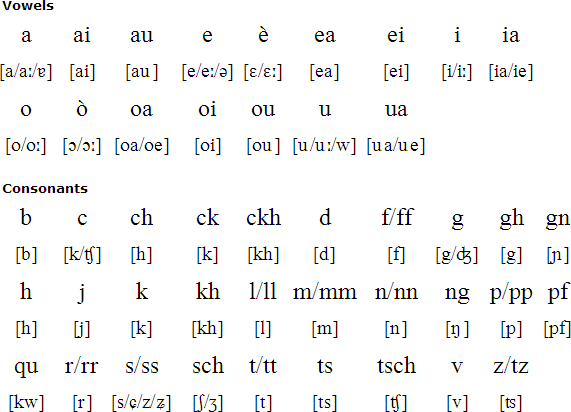Mòcheno language
Spoken in
Indo-European
- Mocheno
-
Acc ( other Germanic languages)
Mhn
The Fersentalerische or Mochenische ( Mocheno: Bersntolerisch, bersntoler Sproch or taitsch, " German ", Italian: Mocheno ) is an Upper German dialect, which is spoken in three municipalities of the Mocheni in Trentino, Trentino -Alto Adige region of northwest Italy.
Origin of the name
The term " Mocheni ", which is used by the Italian and Ladin-speaking neighbors is supposedly " Mochen " to the verb ( = make ) due, as the heels Taler like formed sentences with this verb.
Language assignment
The Fersentalerische is related to the Bavarian dialects and is variously regarded as südbairischer dialect or as a separate language. It is not to be confused with the Cimbrian.
The Speaker of the Fersentalerischen understand reportedly also partially Bavarian, Cimbrian and High German, which suggests to classify it as a dialect. The numerous fundamental differences in grammar, vocabulary and pronunciation, however, prepare high German speakers have problems understanding it.
Linguistic features
The Fersentalerische shares most of phonetic and grammatical features with the other Bavarian dialects. Thus, Middle High German ei oa, ie to ia, uo become, among other things, and iu ai: HOAs ( hot), boachen ( soft ) schiasn, ( shoot ), guat (good), Yeshua (shoe), taitsch ( German ) hait ( today). As in standard German are Middle High German î û to ai and au to broken: AISN (iron), bail ( while), house ( house ), clean ( clean).
With the other language island dialects of the Eastern Alps, including the Cimbrian and Gottschee Rischen, it shares changes of f / v and w. The v [ * f] of the Middle High German - in NHG anlautendes f or v - is always spoken voiced as standard German w [v ]: vimva (five), lavas ( run ). Middle High German w [ β * ] - and neuhochdeutsches w [v ] - might b: boch (week ), schbai (pig), baschn ( wash ).
As in Cimbrian south Bavaria and other dialects is breathed k from Germanic * k: khloa ( small), khotz ( cat).
Originally auslautendes n often omitted: mai (my ), khoa (no ). However, it remains the infinitive of verbs receive: ESSN ( eat ), hòltn (hold).
Grammar
The conjugation of verbs is largely simplified. Unlike in many other Bavarian dialects, but as in the written German, the forms of the 3rd person plural as the end of the first person plural in-n. In the present tense are in the conjugation no umlauts ä, ö and AEU formed: vòlln - he vòllt ( fall - he falls ). However, there is still an umlaut i from e, in all three persons of the singular: Sechen ( see): I to you sichst he considerate, Sechen biar, ir Secht was, Sechen.
As in the other Upper German dialects the past tense is lost and is replaced by the perfect tense. The past participle is formed with weak verbs ending in- t, with strong verbs by ablaut and the ending - (e ) n The prefix ge - of the past participle is usually reduced: i hon tschrim ( I wrote ), i pin khemmen ( I came ).
Unlike in Bavaria no old dual forms in the second person plural are used, but as in written German old plural forms. So is "their" not there / Aus, but ir Therefore, the corresponding verb forms receive no -s: ir mòcht ( you do, see, Bavaria: it makes it ). In the accusative and dative, however, the personal pronoun of the second person plural has as in Bavarian Enkh the old dual form and the possessive is enkher.
The declination is greatly simplified. Nominative and accusative usually coincide. The noun is not changed by the case, however, the article in the dative has its own forms. In the personal pronouns, there is the distinction between nominative, dative and accusative, eg i - me - mi ( I - me - me), you - you - di ( you - you - you). The genitive is gone, as elsewhere, lost in Bavarian and is the dative with va (from) replaced.
Vocabulary
There is a vocabulary of Bavarian ago, but there are many borrowings from Italian, for example, macchina (car), appuntamento (meetings ) or veramente (really).
Dissemination
The census in 2001, according to in which for the first time data on the native language were included, Fersentalerische was spoken by a majority in the following municipalities ( number of members of the fersentalerischen language community ): Florutz / Vlarotz / Fierozzo (423 persons, 95.92 %), Palai / Palae / Palu (184 persons, 95.34 %), Gereut / Garait / Frassilongo (340 persons, 95.24 % - together with the village Eichleit / Oachlait / Roveda ). In other municipalities of Trentino gave 1,331 persons to belong to fersentalerischen language community throughout Trentino in 2278 or 0.5 %. According to the 2011 census, the percentage of speakers of Fersentalerischen has decreased: the proportion was 91.9 % in Florutz (442 of 481 inhabitants ), in Palai 92.9 % (157 of 169 ) and 83.3 Gereut % ( 269 of 323 ). In other municipalities, gave 792 people with only half as many as in 2001 Mocheno as a mother tongue, in the whole of Trentino 1660 by 526 510 or 0.3 %. Field observations indicate that the entire population of Eichleit and Palai, a majority in Florutz and only a few older people in the village speak Gereut Mocheno. A 2007 survey among primary school pupils in Florutz revealed that 47% do not speak Mocheno and not even understand 19%. The high figures in the census suggest that with limited or lack of knowledge of the dialect is a strong identification with the language group even in individuals.
Official status and use in the school
Since 1987 Mocheno is recognized as a minority language in Trentino next to the Cimbrian and the Ladin. In the primary school of Florutz the dialect is offered as a compulsory subject from the first grade to the last few years. In addition, there are at this so far the only school in Trentino - tentatively - two teaching languages: Italian and German. A study in 2009 found that children with knowledge in the vernacular had significant advantages in the German lessons over previously monolingual Italian peers.
Unlike the Cimbri, believe that their Cimbric language with its own scriptural tradition in the seven communities rather than their own language, heels Taler understand rather than in German - taitsch against balsch ( Welsch ). A role may play here is that there were 1860-1918 in Fersental schools with tuition in German language.









